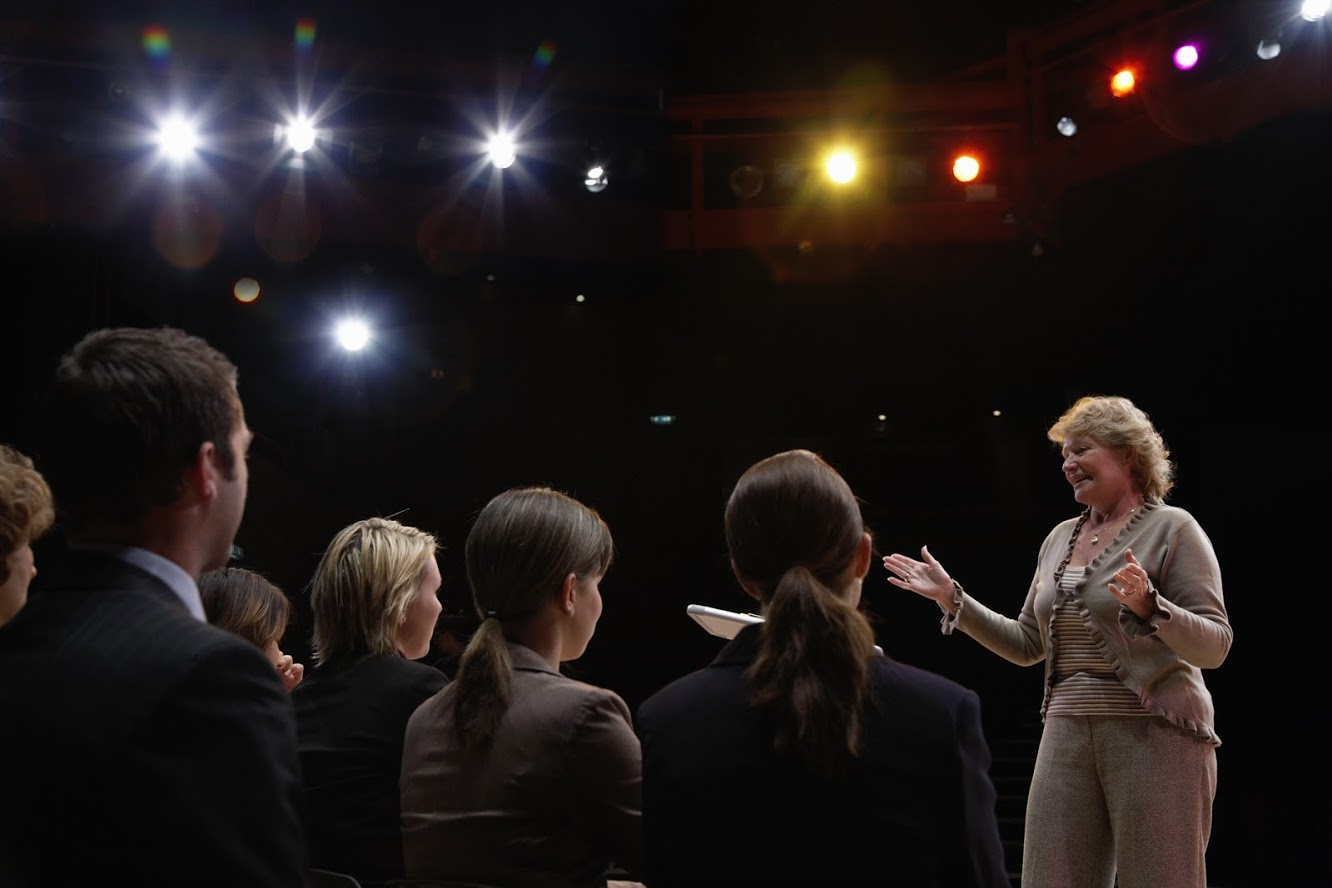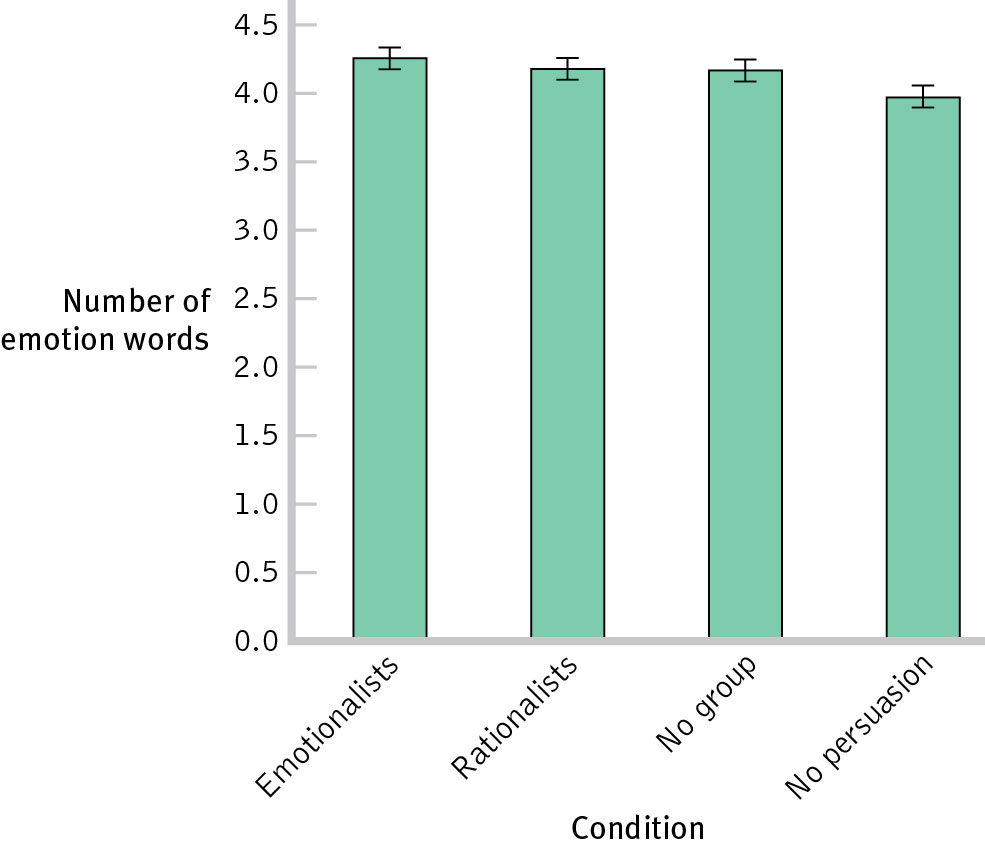Chapter 1. Choosing and Reporting Statistics
1.1 Choosing and Reporting Statistics
Welcome
Is There Power in Passion?
Authors:
Kelly M. Goedert, Seton Hall University
Susan A. Nolan, Seton Hall University
Kaylise D. Algrim, Seton Hall University
Plenty of politicians, businesspeople, and debate captains will say that stories and feelings are more effective than facts and figures in winning an audience. But is going for the audience’s emotions always the right tactic? A series of studies looked at whether people would try to go for the gut (attempt emotional persuasion), even when talking to a crowd less likely to be moved by emotion (Rocklage, Rucker, & Nordgren, 2018). In one study, researchers had participants make arguments to one of three groups: an invented group called “the Emotionalists” made up of artists, dancers, and musicians; an invented group of rational thinkers (e.g., scientists, mathematicians) called “the Society for Applied Rationality and Mathematics”; or a group without a descriptor. In a fourth condition, the participants were not told to persuade any group. The researchers then calculated the strength and number of emotion words that participants used.

Question 1.1
wJLTcbPFNRJdC9NofOb3glwxLQ459E3xxEgRkkfvHvqyAfMk5fygN6GRy9Ho5YEBVfgex7MfQvIQTqmzO0cKncF8WadQMAZlLoGtbKK5hLOAuzirYWsda+TODuXkxwLSGe/VjSaQtNejUoXA/KYGBYL2FJ84iuYVX65aDm7P4QJvFkY98XWyE8s2/5ARxKNWoXzAUeoFPs14zDFufWIpMm5pWcZUyspJjgWuFrJhVsbpHHFimRLyzrqkB8/nn5xAujoTXR7IIKY76EfuLKghc5zbRUe4zR2Q2lpYawHQewK3T4F4GGnjOWxY4XUgGufHIj1k+xRni6Io22QuA2xHCTFAW6BHdKjgg1+k6mvV+GFmi0ygEF0EzY8MhNpKraaCho1LowPSfqwrMQJRjdjyq7YVMhW2YYcqtJ4IVeQ5xbC6kI9e15IwZA3Og1HWZr/NbWLJK2oLRzrfW5tOGuFSEU87uUtEsB1kgkIhphCOqNqzXJ+80/CRvuMzYBh04MWf0BJNEJqOQKYJC8qFAjUlQsp3gXz36xLz6xtDTNwgl0mPlD8p5cxePeMHfKORUAJFNKCxJq7AB+M+DD9w04rMLUE6SbRrikYYakAxr2NLuhd8oIhKLL4SsfIWUjrHx+yKLeRCinwwzynevVnw5U0SXDcTl3UADCZeotaECpaEY2G8hoXWh9bgFLzfLxP2zGLfQEuhlV6X7fvL6+Ebyt15WYo0rWnmxwB1u9zIyv0SwybtY0aOHaqc49enQ/uGDDciczNhim4Q6WZCqZWP9qOaXiA1ogOcVKFd/y4GM36Q8a+XLOpf1bCtS44gssJTcyFa2jZ+inXoXJ1PB2HazW/mwcEeBRs/ASMSF6+YKSfX2hEj2YQ91.2
The researchers conducted a pretest to confirm that participants would respond differently to the emotional and rational groups. Participants in the pretest were asked to rate both groups (emotional, rational) on a scale ranging from 1 (“cognitive, rational appeals would be more persuasive”) to 5 (“emotional, feeling-based appeals would be most persuasive”). A statistical analysis “indicated that participants believed that the group of scientists, mathematicians, and economic analysts would be more likely to be persuaded by cognitive appeals (M = 1.26, 95% CI = [1.16, 1.36]), whereas the group of artists, dancers, and musicians were thought to be more likely to be persuaded by emotional appeals (M = 4.46, 95% CI = [4.31, 4.61]); t(49) = 15.24, p < .001, d = 2.16” (p. 755).
Question 1.2
dD/yzFSn/2PYax8bdt2mM2ZrVdL2dObM/dYAje25u1zsuXBLh0mA6UdBFzTTjmJdK0yLiYpk0vEYRxaswpFDQKrrCnFVA5CZUb0SSLHJgjcqkJfnvC5io8wLWAxUsIpm3TS/PVBjiyGQP5LEQYH4q1dMmyNiwm3zVfkH6R4r2/Xk30FT5qiUkhUk9K0IJ4zevP/WuBoyEC9VuZDxXO880tIXyj09UiTvkhTT2jZLkZC73bsURAOVEHX1EA6Zzt8EJEzAQUjCqoOjy09zi96gWLQWEBNTYssEonp655WqKrNrSd2+323JZBw0axQjRTYCmoPOc72jZjUAHnE0w43KXa7EnhDIcFXlP9hjD4R8B4+69GnJLFJaxSnfggA=1.3
The researchers wrote: “[W]e preregistered our experiment and analysis plan (https://osf.io/vbuqn/).” In addition, they reported: “As detailed in the preregistration, a previous pilot test demonstrated a small to moderate effect size. . . . A power analysis indicated that based on this effect size, we required approximately 800 participants across the conditions” (p. 755).
Question 1.3
B0wW6jgu64kw8V2/kOa7F50qBagTlO/gFJkDkVnT4MeVIqtaFtZkY0AMEjzzw+InO7hydrgbGx4DBCOc/Bge5qOw2apfm79PRP59B8LgkBViERFig7PZ3wCheTYh2tDch8Xsj1PFISSp1baATd7Dcp4PEjLQPkTYfwSwsz9T+l1CrBpkDA5PtOzXep4CDBNi8yFU52TkU4tq+xVAXug0ub4P8mPkgtQ9orxScayfzMUi9r3CLxsKpJ/rPcecakXSzgjGaO92w2/ORPhE1.4
As we noted on the previous screen, the researchers wrote: “[W]e preregistered our experiment and analysis plan (https://osf.io/vbuqn/).” In addition, they reported: “As detailed in the preregistration, a previous pilot test demonstrated a small to moderate effect size. . . . A power analysis indicated that based on this effect size, we required approximately 800 participants across the conditions” (p. 755).
Question 1.4
QgEJ9NWapbZdeMLMKeG+FOElCyZdcS5gnA0nb4lhlYXtWfNNoEYGh64QxaIZx0xH9D7S2a1Q5RkZwlLpD5BvS68vSkNkhFaIQXphJa0YVQmnDc4gTsV5Af9Eewqkc6wkLHeMTjGwlGyJ4ZjCSJjDNfgAlfXwFOQ+ZjcNAMadq4PFpYALmoDG+j+7Atglfy45KAk5nF1pfVymSML0wHwjR8Op/zBxjiJ6d9+QatZZlswjl5nG6TcZJg==1.5
The researchers described their study as follows: “Each participant was assigned to one of four conditions. In all four conditions, participants were asked to recall the last sit-down restaurant they ate at and were then informed they would describe their restaurant to future participants using three to five positive adjectives” (p. 755). In the first three conditions, “participants were incentivized to persuade by being told they would be paid $1.00 each time a future participant selected their restaurant and were also given explicit instructions to persuade future participants to select their restaurant. We then provided individuals with information (or not) about whom they would be persuading” (p. 755)—that is, emotionalists, rationalists, or no particular group. For the fourth group, participants were told simply to describe the restaurant, but were not asked to persuade anyone. The researchers assessed how many emotion words the participants used.
Question 1.5
/4YdEXivs43+9cDAmfilHzPO1j+oKVbr1uqwG2mHM6CY/1oSv/nLGWZR+XzxnkCIuTaq06lxgKjUUNRLKiNCFZMGxsb9BjQLMJ4mKJCvm8ylwDZ7DoZipMLvLuAimNnx1X1V1cYuQLgm2++hJfd3BFFqPlLvqxY9NlxNOkR44mBfs95AM6gdBC3J9UQxvicWcP1LFedwnrPSjOCweG5yXA1ioqsBYczmcgovUkF8vP16NkhMRxD4mmdvACKn3zCfmS5SCYhQJtlRxpyXl32sYKy5z4IIzotBJ+Bd3uvc4g/Hi2zT1qyYTw==1.6
The researchers reported: “We then used an ANOVA to assess the differences in the emotionality of participants’ appeals across all conditions. A significant effect of condition emerged, F(3, 777) = 3.33, p = .019, ηp2 = .013 (see Fig. 2).” [Recall from Chapter 14 that ηp2 (partial eta squared) can be interpreted like R2.] Figure 2 is a graph like the one shown here. As part of their post hoc tests, the researchers indicated that those participants in the three persuade conditions (emotionalists, rationalists, no particular group) all used more emotion words, on average, than did the participants in the no-persuasion group, and they noted that “the persuade conditions did not differ from each other in their use of emotional appeals (ps > .33).”

Question 1.6
zR0vkczU1pj38daM2FkkJ9PtGPBQ+7DfW2TZHt+7IkCqbNGQWtD52jGv0ZVvecikNIRrMfGzVVM5Q1twd6Eq7rB2BHE1F0/C5FeMY3+sH6cMwY2FY5uEAHsW4CKAq2FOaeh7GLLJ5RWI9Hob2HRAkHTcFrdOvAsZPbCdMZRcAAlZGBuSSYSdONsDdqU0kXnllRdSdGvySrlyk0WfbUyy2UL+LJRhIWpzZUFopP0eErIiuEIdsC+iMf4fQNRqugE3VzyPUYTuCzIX5drtnZRBX411FxQ4E6U5tji7WGc2KtCvNmxBZ3eAtIRWy66notYcrN6EXARP19HT1BjTUeFjRvrPbXR/ZhUMnEjjVq4mvDaltNC2m1HCmZ+yb37QvyYB7bJRxBAd5bVrrIp32L8ydkHmKumQQz1ZCurl3pTd0PP3MF9tzZ0a/5iiGJYLsoLOeiU0ez7ns7Bq4Lf0k8YeJe9fPMorGnZAm+Q0jCNq+pJ9YqBYi/D/gHc7vfEPH5I4o9joNChovZifqqz3HffdKqHILUbsGFNryTcmraVoOtKdPbf9e0P104MZPxfCA6Bn0ogWlNlhfP9qBgb8QQH/B5kY81OMDhWDqjCAt6LABgMjvgNZ+LkSoO0ZRRsmgGYlS/s3j8RRDiDQ6Qp0tCGvYI4XoMLiYhU+5Wh33MvKr7/FElyBuSrK6sCvVXyOaAVdeC0vz8xMOq2DdtRuX1hBmpukZ2Qpr8VhHtnxFtkoJ//Grw6MvBbb4mFpms146VZ3k4/mUJWEqOTlAbeTvJRIAZdUqHEuEGA4uL6FHnfNH1riAMBs4VatlG1vftN4jDg9bDbY4qtBuDuF3ImHSU4RRaBcez1A7zVc/ZOzyH1zX5W5kTCqRDMMNrOJgPFUEqWUzsrTOq0vw4WaImO3Sz4pOzayAixs9WDlxv3LlA==1.7
As we noted previously, the researchers reported: “We then used an ANOVA to assess the differences in the emotionality of participants’ appeals across all conditions. A significant effect of condition emerged, F(3, 777) = 3.33, p = .019, ηp2 = .013.” [Recall from the chapter on two-way between-groups ANOVA that ηp2 (partial eta squared) can be interpreted like R2.]
Question 1.7
2ikkOZQ0UpOtuj6wH4HBvqNJrze77RJK2zLokedBjGENN3SxrRiULZSVQGmZgu3iGFnz6vv14q2xOBAV0qyURQeaBfQKu/PtyeNmyJGkbFBCXWMsp4cNKSQPYsCEhgIfN/8nD0MZqpF/VTyDpxpFpqWM+pyjC/8MPOXZnfN+CXp8i0O5IVrjB77mrzECRmHqY3rUwTQkivCob8qOZp8buY3jrE7snJNVT3m1XvCdfMF25UBQMf6kPBjqoRHfGlTFMoNAHcZkpdNVPr4QN21B5Czn9BZPLVRGWRIkL4uyKSG9D770OkpQFFu9OCibsNYowKgC1b4/7hOY7KDHjzKXfeLw6aC3FfAWtW6DjwW5Snk=1.8
The researchers summarized the findings of this study by noting that “individuals continued to infuse their language with emotionality even when they were told that their goal was to persuade individuals who would be more likely to be persuaded by cognitive information” (pp. 756–757). They later went on to place these findings in the context of the overall research literature: “The current findings build on the social-functional perspective of emotion as a natural tool for communication and social influence (e.g., Frijda & Mesquita, 1994; Keltner & Haidt, 1999; Van Kleef, 2009).”
Question 1.8
AuTZ7tVycyWVDpqMHAxubAkv696YfS2gYbqtC4Nwqj3GPZfJ07o5FabjsSXx99AMzo+pOjIuMhU5JmaUvbq7zhixcxwuS8Lfd7hpzUVpDUNN82ReW3S0nY7NMfjlUSMS9Ylr6IRoAD1FBiKy/qfVbhSPqnj6f7RPb5fAuYoX+OIJzUIj7b8qRm3wQ9FRASwyK8uifgNVLFMD6119Wf5btnOtwK3/0mO39IyKapMmWARmwrBJK/+H43JWv32wIYGEIdLCun6Blv9mllk7eYwqA1PiKxY1msRSQR6i8FYlpRU4rcMs1.9
The bottom line: People think the way to change minds is to shoot for the heart—no matter whom they’re talking to. When you’re using sentiment to pull someone to your side, consider whether your emotions might be misleading you, and a rational approach may be a better fit.

REFERENCES
Rocklage, M. D., Rucker, D. D., & Nordgren, L. F. (2018). Persuasion, emotion, and language: The intent to persuade transforms language via emotionality. Psychological Science, 29, 749–760. https://doi.org/10.1177/0956797617744797